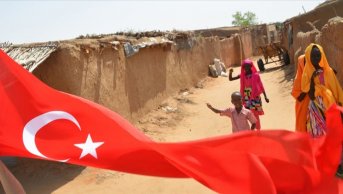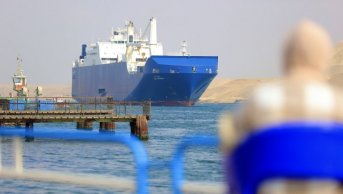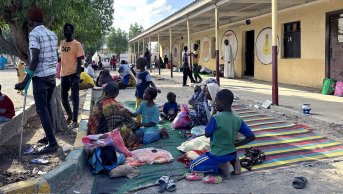Sudan’s Breaking Point: The Deepening Conflict and Possible Solutions

After the overthrow of Omar al-Bashir's 30-year regime in 2019 through a popular uprising, Sudan entered a political transition period. However, this transitional government, which included civilians, became the scene of a power struggle between the military and the paramilitary Rapid Support Forces (RSF) in 2021. This situation led to the outbreak of clashes between the Sudanese Army and the RSF on April 15, 2023, which quickly spread to various states, particularly the capital Khartoum and the Darfur region.
In recent months, the civil war has intensified in North Darfur state in western Sudan, threatening the country's overall existence. The RSF is trying to seize control of North Darfur by besieging El-Fasher, and the support of local social structures for the RSF facilitates this process. The fall of El-Fasher could lead to the complete control of Darfur by the RSF, worsening the already deep humanitarian crisis in the region. Therefore, this article focuses on the background and current situation of the conflict between the Army and the RSF, as well as the possible scenarios in the context of a potential new division.
Background and Current Situation of the Conflict
The roots of the current conflict date back to the removal of then-Sudanese President Omar al-Bashir in 2019 and the subsequent political transition process. The RSF, established by al-Bashir to suppress internal uprisings, especially in Darfur, has become a powerful paramilitary actor under the leadership of Mohamed Hamdan Dagalo (Hemetti) and played a leading role in the removal of Bashir’s regime. After the coup, the alliance between Sudanese Armed Forces Leader General Abdel Fattah al-Burhan and Dagalo formed a transitional government by agreeing with civilians in August 2019, but in October 2021, they arrested civilian leaders and excluded them from the administration.
However, disagreements between Burhan and Dagalo continued, particularly over how the RSF would be integrated into the regular army. This issue became a significant source of tension as part of a broader political transition plan and military reforms. In fact, the Political Framework Agreement signed in December 2022 between various civilian groups and military elements did not resolve the issue of integrating the RSF into the army.
Currently, clashes between the Army and the RSF have spread from the capital, Khartoum, to other regions such as Darfur, North Kordofan, and Kassala. The conflicts have resulted in the deaths of tens of thousands of people and the displacement of approximately 10.7 million people, making the Sudanese civil war the world's largest displacement crisis. Despite the Army's superior firepower and equipment, the RSF has been successful in urban warfare due to its mobility and tactics.
On the other hand, El-Fasher, the centre of North Darfur, is besieged by the RSF, which is attempting to seize control of the region. Additionally, the RSF has established dominance in large parts of the capital Khartoum and various states in the Darfur region. To date, over 25 million people have become dependent on humanitarian aid due to the conflicts in Sudan. Considering Sudan's total population of 50 million, the magnitude of these figures becomes clearer. Indeed, the UN and international aid organisations emphasise that humanitarian aid in the region is insufficient. The UN reports that Sudan is facing its largest displacement and hunger crisis.
International Reactions
International reactions to the civil war in Sudan have been quite diverse and often insufficient. The UN and the African Union, in particular, have not had the expected impact. For example, although the United Nations has called for an immediate cessation of hostilities and unimpeded access to humanitarian aid through the Security Council, these resolutions have not been effective on the ground. Additionally, the UN Human Rights Council established a "Fact-Finding Mission" to investigate human rights violations in Sudan, but this mission has not been fully functional due to personnel and funding shortages.
The African Union (AU), despite holding an emergency meeting to call for peace and cease hostilities, has not demonstrated leadership and concrete actions proportional to the intensity and scale of the conflicts. For instance, at the AU’s annual summit in 2023, the situation in Sudan was not addressed as an independent agenda item.
The United States has appointed a special envoy to Sudan in recent months and imposed sanctions against the RSF, aiming to halt the attacks on El-Fasher in Darfur. The Treasury Department has frozen the assets of RSF commanders in the US, while the State Department has emphasised that the RSF's military operations endanger civilian lives. UN Secretary-General Antonio Guterres has also called attention to the humanitarian crisis emerging from the RSF's attempts to capture El-Fasher, urging immediate action to mitigate the situation.
Regional organisations like the Intergovernmental Authority on Development (IGAD) in East Africa are concerned about the impact of the conflicts on regional peace and security. IGAD has convened emergency meetings with the participation of heads of state from member countries, calling for a cessation of hostilities. Additionally, significant leaders like former South African President Thabo Mbeki have called for an end to the conflicts, though these appeals have not resonated with the warring parties.
Therefore, the international community's response to the conflicts in Sudan has generally been inadequate and ineffective. Many international organisations and countries have called for an end to the conflicts and addressed the humanitarian crisis, but concrete and effective steps have not been taken. The decisions of organisations such as the UN and the AU have not been reflected on the ground, and humanitarian aid efforts have fallen short. This has led to the continuation of conflicts and the deepening of the humanitarian crisis.
Possible Solutions
From this perspective, four different scenarios can be highlighted for Sudan's future. These include military resolution and division, agreement and temporary peace, deepening crises, and international intervention in the context of a peacekeeping mission. Firstly, the decisive victory of either the RSF or the Sudanese Army could lead to regional control becoming definitive and potential divisions. For example, if the RSF takes control of the entire Darfur region, it could strengthen regional independence demands and lead to the de facto division of Sudan.
Secondly, increasing international pressure due to the humanitarian crisis could result in an agreement and the initiation of a temporary peace process. In this context, a temporary governance model could be created, with strategic regions like Khartoum and El-Gezira being left to the army and Darfur to the RSF.
A third possibility is the continuation of the power struggle between the parties. However, this would lead to increased violence and deepening humanitarian crises in various regions of the country. Increasing violence and insecurity would result in more people being displaced and an increase in migration to neighbouring countries, exacerbating the current crisis.
Lastly, though unlikely, the international community could intervene in Sudan with a UN peacekeeping mission and take a more active role in stopping the conflicts. If this scenario materialises, increasing international aid and funds will be brought to the agenda, which could contribute to alleviating the humanitarian crisis.
In conclusion, the current conflicts and humanitarian crisis in Sudan are deepening due to both the country's internal dynamics and inadequate international interventions. The power struggle between the Sudanese Armed Forces and the paramilitary Rapid Support Forces is having devastating effects not only in the capital Khartoum and Darfur but throughout the country. Disagreements during the political transition process that began after the overthrow of Omar al-Bashir and the failure to implement military reforms are the fundamental reasons for the current chaos Sudan is facing. Ineffective responses and insufficient humanitarian aid from the international community are hindering concrete steps towards resolving the crisis. Sudan's future largely depends on the willingness of the warring parties to reconcile and more effective and determined interventions from the international community. Future scenarios include military resolution, temporary peace, a deepening crisis, or international peacekeeping intervention. However, urgent and effective steps need to be taken to prevent the further worsening of the humanitarian crisis and alleviate the suffering of the Sudanese people.
This opinion piece was published in Turkish on May 28, 2024, on the Focus Plus website under the title “Sudan’ın Kırılma Noktası: Çatışmaların Derinleşmesi ve Olası Çözümler.”




